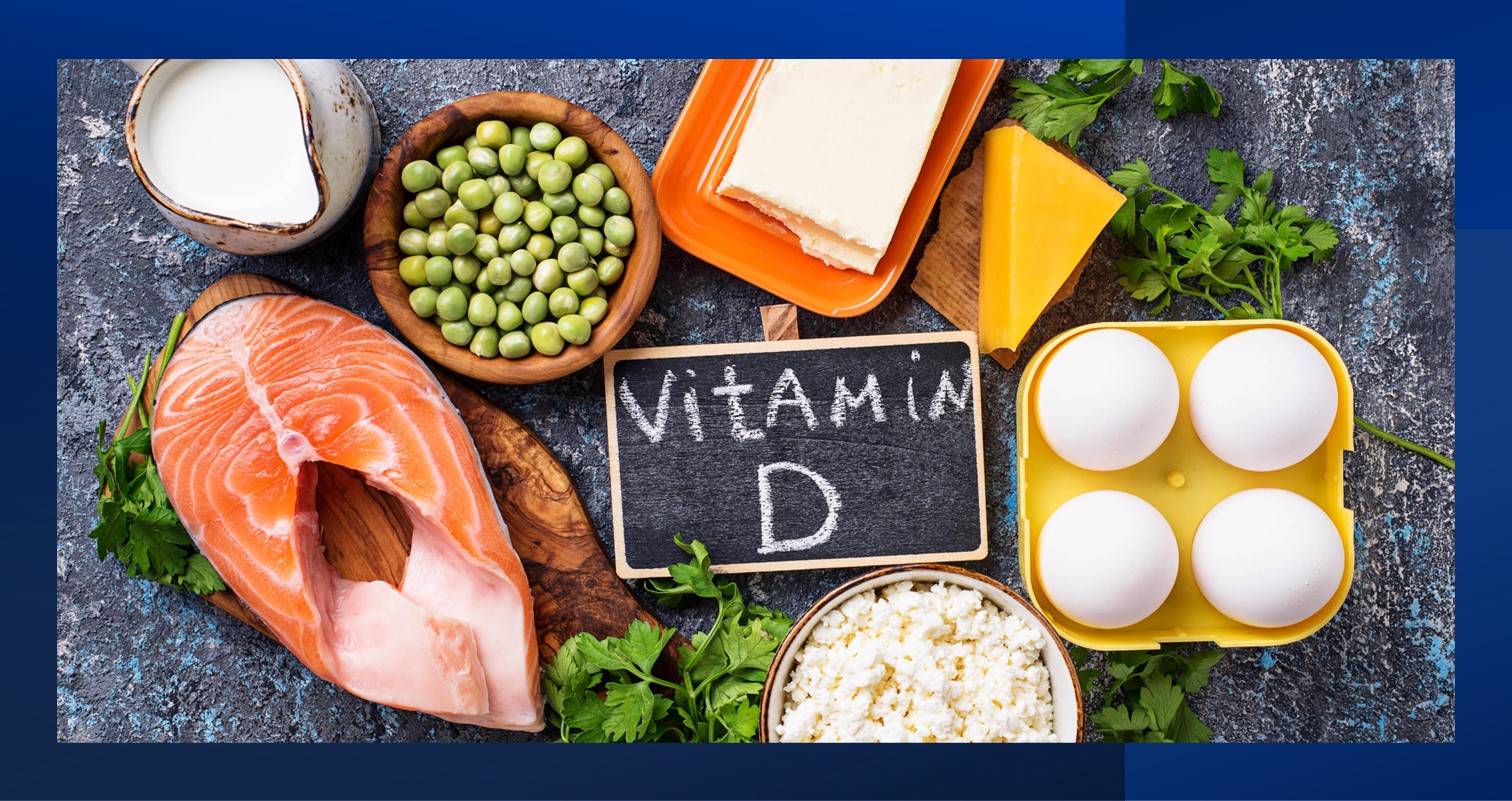
All you need to know about Vitamin D
We have heard about vitamin D and its health benefits, but do we really know what vitamin D is? How many types there are, where it comes from and its function in our body? In this article we tell you all you need to know about vitamin D.
What is vitamin D and where do we obtain it?

Vitamin D is an organic liposoluble substance that is one of the 13 essential vitamins for the human being1. Unlike what is commonly believed, obtaining large amounts of this vitamin is not only dependent on your diet; in fact, only a handful of foods naturally contain vitamin D, including fishes such as sardines, tuna, mackerel and salmon, as well as cod liver oil, egg yolk, mushrooms and liver2.
In fact, the main source is ourselves: most of the biosynthesis of this vitamin takes place in our skin, through a chemical reaction that depends on sunlight—specifically, ultraviolet B (UVB) radiation3. We produce 90% of the total of this vitamin in this way, while we obtain the remaining 10% from food.
In many cases, sun exposure is not enough to produce the amount of vitamin D we need, which is why additional sources such as vitamin supplements have become a common way of reaching the recommended daily dose (5 µg/day)4.
How many vitamin Ds are there and which are they?
The term “vitamin D” was coined in 1922 and is currently used for Cholecalciferol (vitamin D3) and Ergocalciferol (vitamin D2). One of the differences between these vitamins is their origin. Vitamin D2 is mostly sourced from yeasts and mushrooms, while vitamin D3 mostly comes from animal sources—fish, sheep wool, skin synthesis and in limited amounts, from mushrooms5.
While Vitamin D3 and D2 have similar effects on our body, some studies have shown that vitamin D3 is more stable and has a more powerful effect on our body than vitamin D2. Because of this, there has been a strong scientific movement that concludes that vitamin D2 should no longer be considered as an appropriate nutrient for supplementing or fortifying foods 6, 7.
Molecules belonging to the vitamin D group have been found, namely vitamin D1, D4 and D5, which have no proven effects on our body and are found in nature in lower concentrations 8, 9.
Why is vitamin D so important to the human being?
Vitamin D plays a major part in binding calcium in our bones. Vitamin D acts as a precursor of the Calcitriol hormone, which controls calcium metabolism by regulating its active transport from the intestine10. It has also been positively linked to a reduction of respiratory tract infections, asthma, atopic dermatitis, good muscle function and the protection against certain types of cancer 2, 8.
A vitamin D deficit may lead to a loss of bone density and the subsequent development of osteoporosis, which has been also linked to a higher incidence of falls and fractures, and even muscle weakness, hypertension, autoimmune diseases, multiple sclerosis, type 1 diabetes, schizophrenia, and depression 11, 12, 13.
Current landscape for vitamin D
Due to the importance of vitamin D in our body, there has been much interest around the world to establish guidelines for supplementation aimed at both children and adults, which vary per geographic location based on the amount of sunlight hours.
In Chile, the Instituto de Salud Pública (Public Health Institute, ISP) revealed a study on vitamin D levels in the population. According to the Encuesta Nacional de Salud (National Health Survey, ENS), in 2016 – 2017 84% of women between 15 and 49 years of age showed insufficient levels of vitamin D and 13% of them had a severe deficit. Among seniors, the situation is even worse: 86.6% of them have vitamin D14 deficiency.
In 2020, University of Chile’s INTA, working jointly with Finis Terrae University and Catholic University, with the support of NESTLÉ Chile, performed a study that revealed that approximately 8 out of 10 children between 4 and 14 years of age in the cities of Santiago, Concepcion and Antofagasta, had low levels of this micronutrient before the pandemic, making Chile one of the countries with the highest vitamin D deficits as specified in international literature for this age range15.
In line with this, in July this year, the ministry of health enacted decree 48, establishing guidelines for the fortification of flours and liquid and powdered milks with vitamin D3 by 2024. Among other instructions, this decree establishes that liquid milk will be required to contain 1 μg of vitamin D3 for every 100 mL, powdered milk will need to be fortified with 10 μg of vitamin D3 for every 100 mL and flour with 2.25 μg of vitamin D3 for every 100 grams16.
These public policies have led the industry to address the need to offer food-based solutions to prevent the deficiency of vitamin D and other essential nutrients. In addition, consumers are more aware of the benefits of certain products over others, and have a preference for consuming products with “enriched” and “fortified” claims, or which offer some kind of benefit to their health. Accordingly, MATHIESEN FOOD offers the industry a wide range of products that can help companies formulate healthier products with benefits to consumer health.
Having a good health requires a healthy and balanced diet, which can additionally be enhanced with fortified products or supplements as an alternative, in order to maintain optimal levels of essential nutrients in your body. But do keep in mind that, as we have seen in the case of vitamin D, food is not the only fundamental thing when taking care of yourself—an active life and daily walks outdoors to receive the sun’s nourishment are also essential.
If you need more information, contact us and we will be happy to promptly address your request.
Bibliography:
1.- Vázquez, C. & Cos, A. & López, C. (2005). Alimentación y nutrición: manual teórico-práctico. España. Editorial: Díaz de Santos. Pág.44
2.- Chang, S. W., & Lee, H. C. (2019). Vitamin D and health – The missing vitamin in humans. Pediatrics and neonatology, 60(3), 237–244.
3.- F., Martínez-Ferran, M., Vallecillo, N., Lavie, C. J., Sanchis-Gomar, F., & Pareja-Galeano, H. (2021). Vitamin D and cardiovascular health. Clinical nutrition (Edinburgh, Scotland), 40(5), 2946–2957. 4.- Resolución 394 exenta, “Directrices nutricionales sobre suplementos alimentarios y sus contenidos en vitaminas y minerales. Biblioteca del Congreso Nacional de Chile, Ministerio de salud; Subsecretaría de salud pública. Última Versión del13 de enero del 2005. (pág. 2) 5.- Charoenngam, N., Shirvani, A., & Holick, M. F. (2019). Vitamin D for skeletal and non-skeletal health: What we should know. Journal of clinical orthopaedics and trauma, 10(6), 1082–1093. 6.- Vieth R. (2020). Vitamin D supplementation: cholecalciferol, calcifediol, and calcitriol. European journal of clinical nutrition, 74(11), 1493–1497.
7.- Houghton, L. A., & Vieth, R. (2006). The case against ergocalciferol (vitamin D2) as a vitamin supplement. The American journal of clinical nutrition, 84(4), 694–697. 8.- Cardwell, G., Bornman, J. F., James, A. P., & Black, L. J. (2018). A Review of Mushrooms as a Potential Source of Dietary Vitamin D. Nutrients, 10(10), 1498. 9.- Marazziti, D., Parra, E., Palermo, S., Barberi, F. M., Buccianelli, B., Ricciardulli, S., Cappelli, A., Mucci, F., & Dell’Osso, L. (2021). Vitamin D: A Pleiotropic Hormone with Possible Psychotropic Activities. Current medicinal chemistry, 28(19), 3843–3864. 10.- Kulda V. Metabolizmus vitaminu D [Vitamin D metabolism]. Vnitr Lek. 2012 May;58(5):400-4. Czech. PMID: 22716179. 11.- Instituto Nacional de Salud de EEUU (NIH) (2020). Departamento de Suplementos dietéticos. Vitamina D. 12.- Huotari, A., & Herzig, K. H. (2008). Vitamin D and living in northern latitudes–an endemic risk area for vitamin D deficiency. International journal of circumpolar health, 67(2-3), 164–178. 13.- Nordic Council of Ministers. Nordic Nutrition Recommendations (NNR 2012). (2014) Copenhagen (Denmark): Norden; 2014.
14.- Instituto de Salud Pública de Chile, Vitamina D: Situación actual en Chile. Página revisada el 14 de diciembre del 2021. 15.- https://inta.cl/estudio-revela-preocupante-deficit-de-vitamina-d-en-ninos-y-ninas-chilenos/
16.- https://www.diariooficial.interior.gob.cl/publicaciones/2022/07/05/43294/01/2151264.pdf
















